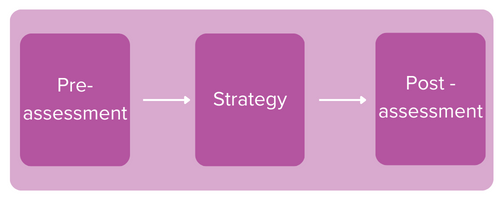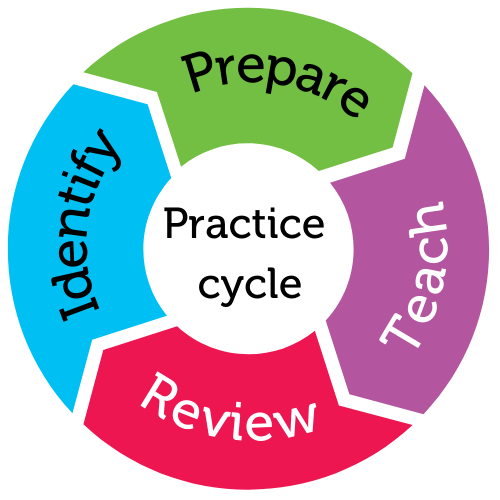
For student year
Helps students to
- retell stories
- recall perspectives
Helps teachers to
- support story telling
- scaffold perspective taking
Summary
Being able to take on the perspective of another person is critical for understanding and retelling stories. This practice provides guidelines and a series of planned, small group teaching sessions to support students to understand the different perspectives of characters within stories.
This practice follows on from Story tool I: Improve story retelling. When students have developed their retelling skills, they are ready to learn how to retell the story from the perspective of different story-characters. It is strongly recommended that you complete the three sessions in Story tool I: Improve story retelling before starting this current practice.
In this video Dr Sofia Mavropoulou talks about Story Grammar and social perspective taking.
Duration: 3:31
Australian Professional Standards for Teachers related to this practice
2.5 - literacy and numeracy strategies
4.1 - support student participation
For further information, see Australian Professional Standards for Teachers AITSL page
Preparing to teach
Developing social-perspective taking to improve story retelling skills
At a universal (Tier 1) classroom level, many students benefit when you introduce and use mental state terms (refer to Table 1 below), and encourage students to think about what story characters know, think and feel. Knowing how a character thinks and feels can help students understand what the character intends to do and to use this knowledge in their story retelling and social perspective taking.
Including mental state terms in story telling with your students will help them to understand the reasons for the characters' actions (Bang, Burns, & Nadig, 2013). This then leads to greater understanding of how the events in the story are related.
|
For example Based on what the Big Bad Wolf says in the story of The three little pigs, you can infer that the pigs are scared of the wolf because he tells them that he is going to blow the house down and eat them. If you didn’t know that the pigs were scared, how would you explain why they run to the next little pig’s house? What would you say in your retell? |
Why does social perspective-taking matter?
To retell a story students need to understand:
- the plot
- the characters' mental states
- why story characters choose to take the actions they do
- language of the text describing the characters' mental states
For students to be able to retell the story from a character's perspective, they need to:
- organise the information in the story so others can understand what is happening and why it is happening (Refer to Story tool I: Improve story retelling)
- use appropriate language to describe the story characters' mental state
- explain the story characters' mental states
| Examples of mental states | Examples of social behaviours |
|
|
For more information download Information on mental states and social perspective taking available in the resources section.
In this video Dr Sofia Mavropoulou talks about social perspective taking.
Duration 2:15
How the story tool strategy works
The Story tool strategy has 3 parts:
- Pre-assessment - used to understand the students' ability to retell stories and identify areas that require further scaffolding. The pre-assessment involves asking the student to retell the story in oral form.
- The teaching of the strategy - see the In the classroom section for more information.
- Post assessment - used to identify if students' ability to retell stories has improved and to gather more information to determine if further support is needed.

Tier 2 support
This practice works best as a Tier 2 approach with small groups, however, it can also be used as a Tier 1 approach.
Tier 2 : for small groups of students who need support with their social perspective-taking in their story retelling. For students in these groups it is recommended that a pre-assessment task be completed to help you gather formative data on social perspective-taking to identify areas of support and scaffolding.
Note: If using this as Tier 1 approach - whole of class- either the Teacher or the students can read the story aloud. As for Tier 1, the teacher asks the students to retell the story from a character's perspective. The students' responses will determine if a Tier 2 approach is needed.
A note on inclusion
To deliver these Tier 2 sessions inclusively, create diverse student groups. The sessions were developed for students in Years 4 and 5 but the researchers suggest they can be used with younger students, who have shown an interest in story reading or would benefit from story-retell extension activities to help them build social perspective taking. The session resources have also been developed using the framework of the Story Grammar Marker (Moreau & Fidrych, 1994).
Pre-and post-assessment
The pre- and post-assessment tasks provide important information to allow you to identify those students who may require a Tier 2 approach to social perspective-taking. It is important that the student has not engaged with the story prior to the pre-assessment.
A story tool resource and assessment rubric can be used with a range of stories, not only those mentioned in the practice. We only recommend using the assessment if you are planning on delivering both Story tool practices.
Tips for assessment
- use an audio recording device such as an iPad or other recording device
- sit beside the student so you can both use the same copy of the story
- describe to the student what is going to happen in the session before you begin
- use verbal or written instructions
- remind the students that there is no time limit for the retelling
- ask the student if they would like to turn the pages as you read
- pace your reading to suit your student
- provide positive feedback and support to the student throughout the process
See the assessment rubric and instructions in the resources section.
Dr Sofia Mavropoulou provides greater information and demonstrations about the assessment.
Duration 4:48
Link to the Australian curriculum
The resources in this practice are used to explicitly instruct students how to describe events, characters, and settings and, to explain points of view and take these into account during group discussions and oral and written story retelling activities.
Appreciating the perspectives of others is a learning outcome of the Australian Curriculum* and the teacher and student resources within this Practice will provide evidence-informed opportunities to support your students to do so. Using the same structure and building on skills targeted in Practice I, students will participate in joint reading, retelling and discussion of a simple story. The focus of these groups is on the social behaviours and perspectives of the characters. between mental states and behaviours and build their understanding of characters in different contexts.
This practice uses the inclusionED Story tool resource. Story Grammar has long been used in different ways to scaffold student story retells and the inclusionED version was informed by the resources used in the research.
Learning outcomes align with Level 3 learning outcomes in social awareness within the Personal and Social Capability learning continuum.
In the classroom
Pre-assessment
Choose a story to use for the pre-assessment. In this practice we used Harry the dirty dog by Gene Zion for the pre- and post-assessment (see the example in the resources section).
- When choosing the story for pre- and post-assessment, it is best to use a story that enables students to focus on the different events happening to the character(s).
- It works best when the story is short - approx. 10 minutes of reading time.
- The whole session should take no more than 10 minutes.
- Reviewing the students' story retelling will identify those students requiring a T2 approach.
Story sessions
These sessions follow on from the 3 sessions in Practice 1. The sessions use the text Miss Nelson is missing! by Harry Allard.
Social Perspective taking session 1
Complete the Beginner Perspective Character Map (Miss Nelson)
- Teacher outlines the session
- Teacher reads the story
- Teacher asks questions from the Story Retelling Script
- Teacher models retelling from the perspective of a character (Miss Nelson)
- Each student completes a perspective-taking map and retells the story from the perspective of the same character (Miss Nelson)
- The student retell is scaffolded using the Story tool resource
- Teacher summarises the key skills learnt in the lesson
- Teacher concludes lesson and gives a brief overview of the next session
Social perspective-taking session 2
Complete the beginner Perspective Character Map (Miss Swamp)
- Teacher outlines the session
- Teacher reads the story
- Teacher asks questions from the Story Retelling script
- Teacher models the story from the perspective of a character (Miss Swamp)
- Each student completes a perspective-taking map and retells the story from the perspective of the same character (Miss Swamp)
- The student retell is scaffolded using the Story tool resource
- Teacher summarises the key skills learnt in the lesson
- Teacher concludes lesson and gives a brief overview of the next session
Social perspective taking session 3
Complete the advanced Perspective Character Map (two characters)
- Teacher outlines the session
- Teacher reads the story
- Teacher asks questions from the Story Retelling Script
- Teacher models retelling the story from the perspective of two characters (Miss Swamp and Miss Nelson)
- Each student individually completes a perspective-taking map and retells the story from the perspective of two characters. The student retell is scaffolded using their Story tool resource.
- Teacher reads the story for the final time
- Teacher and student reflect on the story characters
- Teacher summarises the key skills learnt in the lesson
- Teacher concludes lesson and praises students for their participation
How will you know if students’ story retells benefit from the sessions?
In Story tool 1: Improve story retelling, we recommended assessing students if you are going to deliver all six sessions across both practices. The assessment can be found in the Story tool I: Improve story retelling inclusionED practice.
By using this assessment before and after the six sessions, you can evaluate if your students benefit from the story sessions. Some students may need to participate in repeat sessions.
Practice toolkit
Practice implementation planner template
We know it's not always easy to keep track of what's working and what isn't. So, we've created this template for you to record and reflect on what you're doing to create more inclusive classrooms. The implementation planner contains:
- guidance around goal setting
- a reflection section (what worked, didn’t work, what to change, and next steps)
- prompting questions.
Implementation planner with examples
Set your professional learning goal for:
Story tool II: Improve social perspective taking
Benefits of goal setting
Setting, working towards, and reflecting on goals helps you grow professionally and improve your practice. You can access AITSL learning resources for teachers to learn more about:How to set goals
The Australian Institute for Teaching and School Leadership recommends using the SMART matrix to frame your goal setting.SMART goals refers to goals that are:
- Specific
- Measurable
- Achievable
- Relevant
- Time-phased
Resources
Information on mental states and social perspective taking
Story retelling character maps - Student worksheet
Story tool - Teacher single page
Story tool – Student version single page
Story tool - Teacher folding version
Story tool - Student folding version
Story tool teacher information
Using questions to support learning
Story retelling: Pre- and post- teaching assessment
Social perspective-taking scoring rubric
Related Practices

Story tool I: Improve story retelling
TEACHING PRACTICE
For student years
Helps students to
- retell stories
- sequence events
Learning Cycle
